Retrospective Published Library Catalogs
National union catalog, pre-1956 imprints: a cumulative author list representing Library of Congress printed cards and titles reported by other American libraries
London: Mansell, 1968-1980. 754 volumes
U of I Library Call Number: Main Stacks Reference Q. 017 C 28217
National union catalog
New York: Roman and Littlefield, 1956- ,
U of I Library Call Number: Main Stacks Reference and Oak Street Facility 017 C2822
This invaluable work can be extremely helpful to the scholar researching retrospective material. It is organized by author or, if there is no author by title, so there is no subject access. Each entry consists of a photocopy of the card catalog card for a book or serial. Full bibliographic information is included on this card, as is a list of libraries that hold the book. Many of the titles in this catalog can not be traced through OCLC. This makes the National Union Catalog or NUC a very important source if you are trying to locate a title published before 1956 in this country. The retrospective cumulation, often referred to simply as Mansell, includes only pre-1956 imprints, as its title suggests.
The later volumes, published from 1958-1978 in five year compilations can be more challenging to use. It is important for the user to keep in mind that the catalog registers books as they were acquired. That is the books listed in the compilation for 1963-1967 list those titles acquired by libraries in the United States during those years, regardless of their date of publications. Since materials from this period are often not available in online catalogs this is a useful source for those seeking U.S. library holdings of specific titles. This is a main entry catalog and given that the forms of entry used for many institutions have changed over the years using this source effectively does require a knowledge of library practice.
![]()
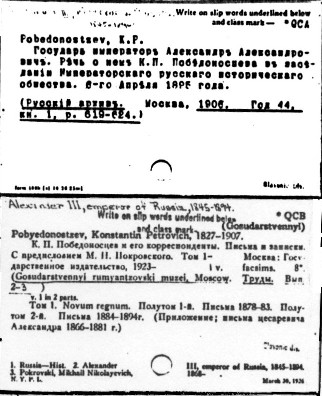
New York Public Library Dictionary Catalog of the Slavonic Division
New York: G.K. Hall, 1974. 44 vols.
U of I Library Call Number: Main Stacks Reference Q. 016.8918 N42d1974
The New York Public Library Slavic collection was established in 1898. This catalog contains all materials cataloged up to 1972. It is a remarkable catalog in many ways.
As a “dictionary” catalog, the catalog entries are filed under author, title and subject. The entries are thorough, often including periodical holdings. One of its more unusual features is the occasional inclusion of a catalog entry for a periodical article. The upper entry at the left is an example of this rather unusual type of catalog entry. Most library catalog entries only include monographs and periodicals, not the contents of periodicals.
The lower entry gives some idea as to the type of record one can find here. The information is as one would expect in a library catalog. New York Public Library has an especially important collection of emigre materials which are recorded in this catalog and in its online catalog.
For publications acquired at this institution after 1972 see the online Classic Catalog.
Slavic Cyrillic union catalog of pre-1956 Imprints
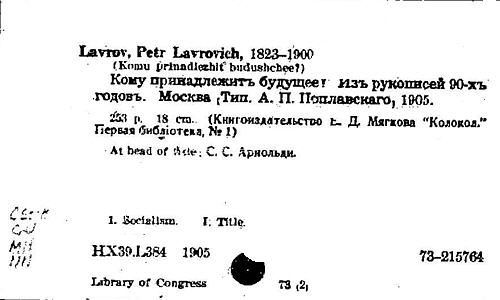
United States. Library of Congress. Catalog Publication Division. New Jersey: Rowman and Littlefield, 1980. 174 microfiche
U of I Library Call Number: International & Area Studies Ref Microform Room MFICHE 016.8918 L616S
Cyrillic Union Catalog
United States. Library of Congress. Cyrillic Bibliographic Project. New York: Readex Microprint. 1963. 1244 microprint cards.
U of I Library Call Number: International & Area Studies Ref Microform Room MCARD 016.8918 UN3C
The Slavic materials in this list are Cyrillic alphabet publications issued before 1955. Information on the holding institution for each item is included. Titles are located in many libraries from the Library of Congress to any one of the 220 selected North American libraries whose holdings are included in the catalog. Books, pamphlets, maps, atlases, periodicals, and other serials are listed by author or, if the work has no author, by title. Russian, Church Slavic, Belorussian, Ukrainian, Bulgarian, Serbian, and Macedonian materials are included. The libraries which hold copies of a work are indicated with abbreviations.
This entry gives some idea of the information in the Slavic Cyrillic Union Catalog. In this particular case the list of holding institutions, handwritten on the left-hand margin, is not too lengthy. Holding institutions are listed using the same abbreviations found in the National Union Catalog. A list of these abbreviations can be found in the accompanying brochure.
The place of publication does not determine inclusion in this catalog. Materials are selected on the basis of the language of the publication regardless of place of publication.
The Slavic Cyrillic Union Catalog includes updated versions of all of the entries in the earlier Cyrillic Union Catalog, plus many new entries. However, the Cyrillic Union Catalog is still valuable because it provides a subject organization not available in the Slavic Cyrillic Union Catalog. This older catalog was produced on microcards and requires a special reader for viewing.
![]()
Union list of serials in libraries of the United States and Canada
Titus, Edna Brown (ed.) New York: Wilson, 1965. v. 5
U of I Library Call Number: Multiple locations, including International & Area Studies Ref Slavic Q. 016.05 UN331965
While extremely outdated, this source can still be very important for locating serials. A bit of background on this title will clarify its early significance. The list includes 156,000 titles with holdings of 956 cooperating libraries. Every entry includes a full bibliographic description using the “latest form” of the title, the dates indicating the complete run, title changes and exact holdings reported by libraries. The list does not include government publications other than periodicals, United Nations publications, almanacs, gift books, newspapers, and a list of other publications primarily of specific types of organizations.
While this is not a source to consult first, it is one you may want as a tool for older titles. If you do not find a title in the online catalogs, and it is an older publication it is possible it was never converted to an automated record that could be used in WorldCat. If this is the case, the title may be held, but record of those holdings will only be available in the Union List of Serials. It is also a valuable source for identifying the proper form of entry for a periodical title. As was noted in the introductory comments on library catalogs, the form of entry used for the name of an institution can vary from one catalog to another. This alone makes it valuable given the complexity of some of the titles of East European periodicals.
![]()
List of the serial publications of foreign governments, 1815-1931
Gregory, Winifred (ed.) New York: Wilson, 1932
U of I Library Call Number: International & Area Studies Ref Slavic Q. 015 L6961815-1931; Also available at Oak Street Facility.
This is definitely a source for those working with retrospective materials. However, it should not be dismissed because of its age. The bibliography is organized by country. Each country section is subdivided by government departments, bureaus, etc. The holdings of 85 libraries are included in this source. When you are trying to identify publications in a number of countries, the annual reports of the national banks of Hungary, Czech Republic and Poland for example, this is an excellent starting point. It will also quickly indicate which libraries have a pattern of collecting such material.
![]()
General Online Catalogs
Österreichische Nationalbibliothek
This is the retrospective catalog of the Austrian National Library and a major source for East European publications. It includes records for publications issued from 1501-1929. The catalog is searchable by author, title, subject or keyword and has a variety of capabilities for display.
As can be seen from this record there are two options for the format of the record: standard and card catalog. The catalog must be searched using German transliteration. Records can be sent via email. It is possible to search a subject index and personal name index and most terms in the record can be linked to other records with the same terms. This is a very important source for those working on East European history and should not be overlooked.
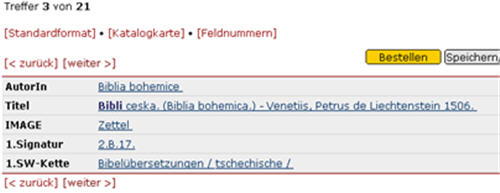
![]()
Helsinki National Library/Helsinki University Library Online Catalog – Helka
URL: http://www.helsinki.fi/kirjasto/en/home/
The catalog of Helsinki University Library has been available for some time. The current catalog contains records of its Russian, Ukrainian, Belorussian and Bulgarian holdings. The online catalog has records for all Russian monographic materials published after 1700.The interface allows for a simple or complex search and also allows for various format for the display of results.
Records can be emailed from this screen or printed. The catalog has an index of subject terms that are especially helpful in finding related records. The older, pre-revolutionary serial publications are not included in this catalog, but Soviet era serials are listed. One of the library’s webpages has a chart that is very helpful for transliterating titles and names in this catalog. A scanned catalog of the Slavonic divisions newspaper holdings will help the user identify Helsinki’s holdings of this important resource.
There are a few scanned catalogs of rare materials available at this site as well.
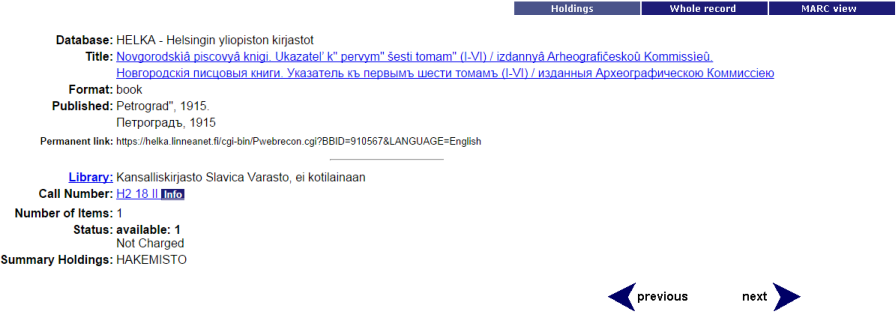
![]()
Karlsruhe Virtual Catalog
This catalog from Germany provides a meta-search capability to search library and union catalogs from many European countries including Germany, Switzerland, England, Austria, Italy, Norway, Sweden, and France. There are even catalogs from the Czech Republic, Poland, and Russia included in the system, as well as some book trade catalogs. It provides access to records for over 100 million books and periodicals in libraries throughout the world, but mostly in Europe. There is an English interface, so no need to worry about German. However, that is not to say that German libraries are not important, for German libraries collect heavily in the field of Slavic Studies. Records from German libraries for Slavic language materials frequently turn up in WorldCat searches.
The searcher can select all of the catalogs from a particular country or select just a few catalogs to search. The results list is very easy to digest with a selection of records from each catalog searched and the total records found. Once you click on a record you are taken to the individual catalog. Karlsruhe provides just the search and display mechanisms. But the simple interface is deceptive. The same problems that we have discussed above regarding Romanization apply. For example, if you do a search for author name Tolstoy, you will get different results from an author search for Tolstoi, and from Tolstoj. And this difference does not just pertain to multiple country searches, but also across multiple catalogs from one country. If you do the above-mentioned search for all of the libraries in Germany, you will get three different sets of results. Searching in Cyrillic is not an option, not even for using this interface to access the one Russian library available via Karlsruhe. In fact, trying the three different spellings just in the Russian State Library catalog via Karlsruhe results in 4099, 5627, and 5571 hits.
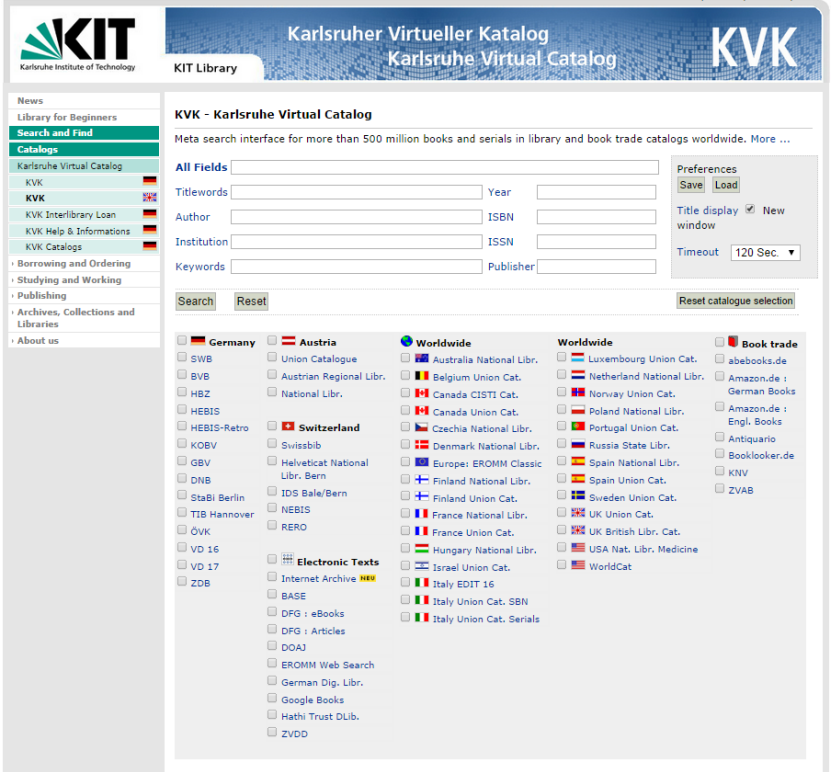
![]()
OCLC-WorldCat
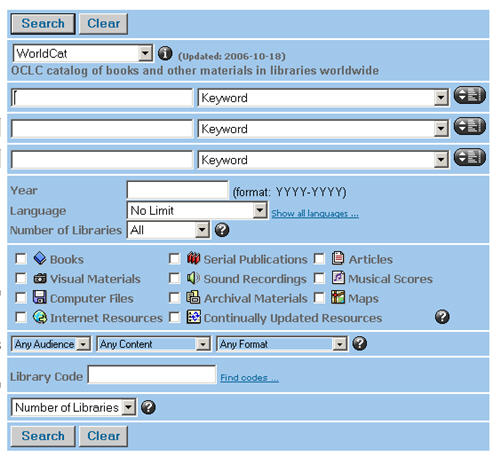
WorldCat is the union catalog of books and periodicals for libraries participating in the OCLC database. What this means is that you can find bibliographic records for the holdings of some 10,000 libraries worldwide. All languages and subjects are represented. Using it in conjunction with your InterLibrary Loan department can make vast amounts of material available to you at your home institution that would previously have required a research trip. For the researcher it is a treasure trove of material, but it has a few idiosyncrasies that can be misleading.
A bit of history can help explain the problem. OCLC became available in the late 1970s for Slavic materials. At that time libraries started adding their Slavic holdings to the database that would become WorldCat. Some libraries have been able to go back and enter all the records for materials that were held in their libraries before that time. However, many have not had been able to do this as it is extremely costly. Therefore, it is perfectly possible to search for a title such as Pravda in WorldCat and not find any record of the holdings at the University of Illinois, or only limited holdings. This would be because we would only add that title if we received it in some new format and, therefore, had a new record for it. The fact that we have a complete, circulating run of this title would be completely overlooked.
How does the researcher work around this problem? There is no fool-proof method. However, if when looking for a title you find in OCLC a large number of holding institutions, or you find very obscure institutions claiming to hold an older title, it is a good bet that the title was cataloged before OCLC came online and the holdings of most institutions will not appear there.
Another important point concerning OCLC and serial titles is that it does not list holdings. It lists only bibliographic information on a title. Therefore, once you have obtained a list of holding institutions for a serial you will need to check the holdings of the individual libraries to verify that a particular issue is truly available. This is possible through WorldCat itself, as it links out to the individual library records of a given material. However, this linking does not always work. Sometimes the link goes directly to the item, sometimes just to the homepage of the institution’s search page, and sometimes the record is linked to a library that does not actually have the item. This last scenario is rare, but it has happened. When in doubt, go straight to the holding institution’s library webpage and conduct a search from there.
OCLC can be rather complex to use effectively, particularly for older materials. It is essential that the researcher remember that this is still essentially a library catalog and requires a knowledge of subject headings and, to some extent, the proper form of institution names as used in libraries, if the more complex serial entries are to be identified. When a title is not found, particularly an older publication, it is really not safe to assume that it is not available in the West. It simply means that it is not listed in this catalog. Like all library catalogs, it is a collection of holdings, not a record of all publications.
Note: The image on the left is the interface of WorldCat as students and patrons of the University of Illinois Urbana-Champaign see it. It is possible that the interface will look different depending on the institution. The general WorldCat catalog is available at www.worldcat.org.
![]()
Major Regional Library Catalogs Online
Most of the catalogs listed below receive a more complete treatment in the sections on the individual national bibliographies. These links are included here to provide an easy access point and some general information on each catalog.
Union Catalogs:
COBISS
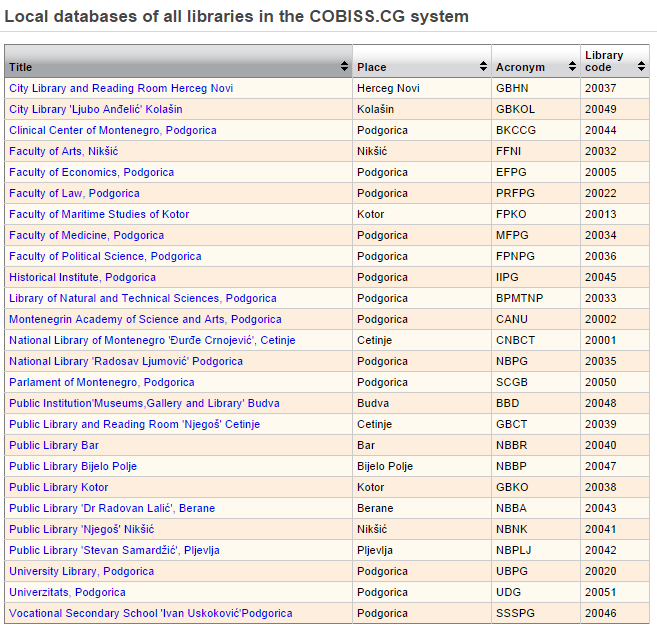
COBISS (Co-operative Online Bibliographic Systems and Services) provides a platform for the national library information systems in Slovenia, Serbia, Macedonia, Bosnia and Herzegovina, Montenegro, Bulgaria and Albania. All these systems are interconnected into the COBISS.Net regional network. While in Kosovo they are preparing themselves for the implementation of the COBISS system, an open invitation for cooperation has been offered to libraries in Croatia, but has not been accepted.
Some of the participating countries and their National Libraries use COBISS exclusively for library catalog and cataloging purposes. As a result, the national library holdings are mixed in with the holdings of other libraries within the same country in the union catalog. COBISS catalogs in all of the participating countries provide a fast and easy way to verify citation information and holding information, as well. This information is essential when trying to place Inter Library Loan requests, or direct requests to the COBISS libraries.
Here is a short list of the COBISS union catalogs for several countries that participate:
Macedonia
This site links the user to the union catalog COBISS as it is used in the Macedonian consortium of libraries. This catalog has the same structure and interface found on many of the other former Yugoslav catalogs. Bosnia-Hercegovina, Slovenia, Macedonia, Montenegro and Serbia are all contributing cataloging to a central source. These records are then being made available for regional union catalogs. In Macedonia the catalog includes listings of holdings for 42 libraries, which have provided 300 links to e-resources, 360,000 books, 126,000 articles, 11,200 magazines, 750 CDs/DVDs, etc. A full description of the search structure and more detailed information on this catalog can be found on the Macedonian National Bibliography page.
Montenegro
Like many of the other republics of the former Yugoslavia, Montenegro is participating in a cooperative project to produce its catalog. A full description is available in the section on Montenegrin National Bibliography. As of September 2014 there were 26 libraries participating in the union catalog in Montenegro; the participating libraries are listed in the image to the right.
Slovenia
For a detailed description of this catalog see our pages on the Slovene National Bibliography. This Virtual library of Slovenia contains the union catalog for Slovenia as well as links to over 400 individual library catalogs. In addition to citations for books and serials, the catalogs include citations for articles too. Through the Slovene version one can use a database to obtain bibliographies of researchers in the fields of science and technology. Search results differ depending on whether or not Slovene diacritical marks are used.
![]()
Crolist
Croatia is not part of the COBISS network. Instead, it has its own union catalog of Croatian libraries call CROLIST. The search interface is in English and no diacritics are needed. The records all display in Latin characters even if the title appeared in Cyrillic. Records for books, periodicals and articles are all available in CROLIST. For periodicals, click on the highlighted libraries under the heading “Available in:” to get the holdings. When you do this, the system takes you out of CROLIST and into the individual catalogs of the holding libraries.
This union catalog is accessible via the national library website. It is searchable with Latin characters only and requires careful transliteration. However, there is a wealth of material available in these libraries. It is very useful for those participating in International InterLibrary Loan as are so many of the union catalogs.
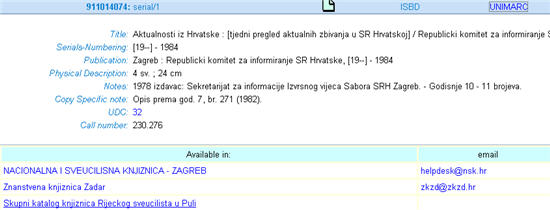
Estonia
This union catalog contains bibliographic records for 15 Estonian libraries. The compilation of the online catalogue started in 1999. Although the catalogue has since been continuously supplemented, it does not yet comprehensively reflect the collections of member libraries. The online catalog ESTER contains records on books, periodicals, sheet music, sound recordings, online resources, etc.
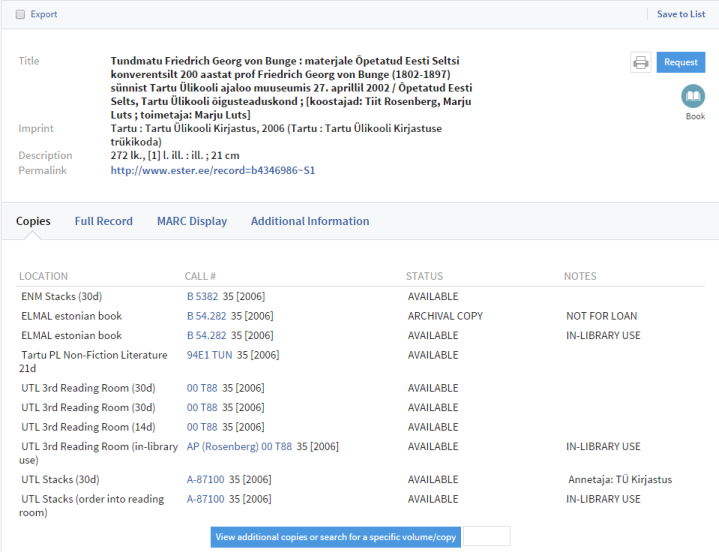
Lithuania – LIBIS
This is the union catalog for over 80 Lithuanian libraries. It includes over 5 million bibliographic records for many formats of materials, from books and periodicals to maps and multimedia. Participating in the union catalog are university libraries, city libraries, the national library, and others.
There are two interfaces – one in Lithuanian, one in English, but the English is limited. Error messages are only in Lithuanian, as are field tags in records and navigation. You may search in Latin or Cyrillic, with or without diacritics, and achieve the same results. One special feature is limiting by country of publication. Once you find a pertinent record, the holding libraries are listed under the rubric “Biblioteka.” When periodical holdings are available, they appear under the heading “Dalys.”
Czech Republic
Souborny katalog CR currently holds more than 5.7 million records of monographs, special documents and serials of foreign and domestic origin. The database provides Location Codes which link to the individual library’s catalog with detailed information on the item. The union catalog participates in Inter Library Loan and resource sharing. The interface itself is the familiar Aleph search, which offers a basic, advanced, multi-base (multiple database) and a CCL (Common Command Language) search.
Hungary- MOKKA
The catalog contains bibliographic records for books, music, maps, periodicals, and other formats from an unknown number of Hungarian libraries. Most of the information about the catalog and its participants is in Hungarian.
The catalog has two interfaces – one in Hungarian and the other in English. Both simple and advanced searches are available. When you find a title, in order to see the locations of holding libraries, scroll down to the section for locations. Hungarian diacritics are not necessary for searching, but with some searching of other languages with diacritics, their use is required. For example, when searching for Czech or Croatian materials, if you search “casopis” with no diacritics, you get 19 hits, but if you search časopis, you get more than 200 hits. Cyrillic materials can be searched in Romanization only.
![]()
Individual Library Catalogs:
Cobib.BH – Bosnia and Hercegovina
As mentioned above, the library catalogs of the former republics of Yugoslavia have a common structure and interface as a result of the large scale project to share catalog information. Thus, the Bosnia and Hercegovina catalog, whose interface is shown below, and the catalogs of Serbia, Slovenia, Macedonia, and Montenegro all have a similar structure. All are fairly easy to search. The use of diacritics is not required but can be helpful in this catalog to sort through long lists of citations. The entries can be viewed in a short form or in the “MARC” structure often useful for libraries. Each record includes links to the holding institutions that have the title. There are 50 participating library from Bosnia and Hercegovina, making COBISS.BH a great way to search multiple locations at once. For a thorough description of the catalog see our section on Bosnia-Hercegovina National Bibliography.
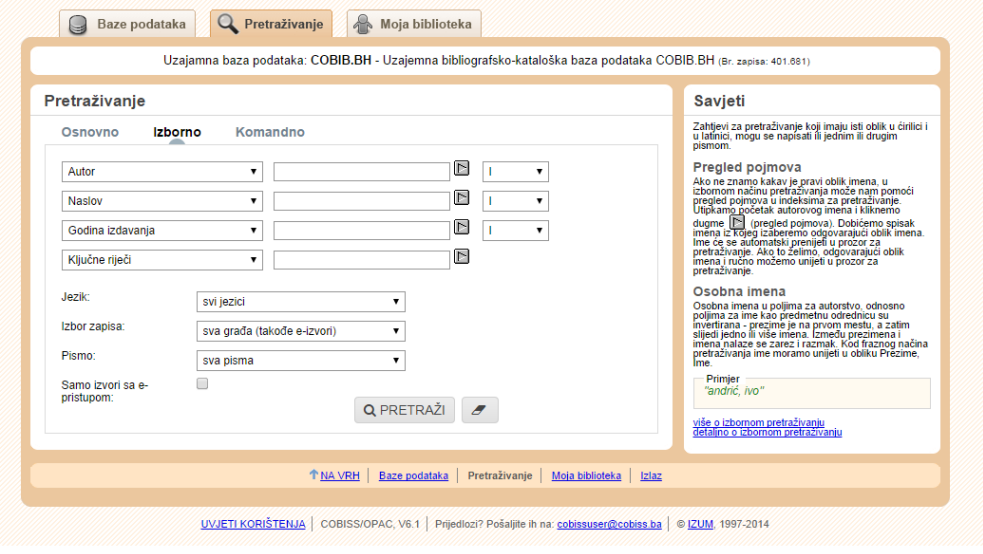
![]()
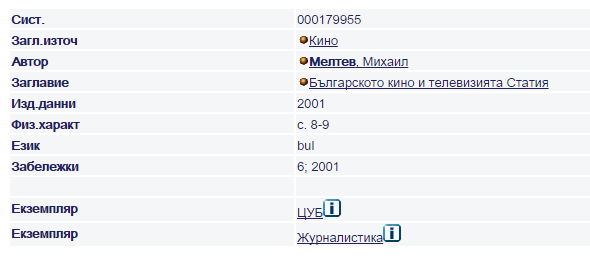
ALEPH Library Sofia University
This web site belongs to the ALEPH Library Sofia University. It can be accessed in English or Bulgarian. If viewing the page in Cyrillic, it is recommended that you set your browser to Cyrillic encoding (ISO8859-5). Bulgarian language entries in the catalog must be searched using Bulgarian characters. That is, while the catalog has an English language interface, searching in Latin characters will only return entries for items published in Latin scripts.The catalog contains references to books, periodicals, articles and other documents and can be searched by author, title and subject. There is a link to the Sofia University Library and the Sofia University “St. Kliment Ohridiski”. The University Library works as a unified centralized system which consists of a Central Library and 25 branch libraries with the respective departments and chairs of the University. Thus, this page plays a central role in the university system. The page is maintained by University of Sofia “St. Kliment Ohridsky”. While the National Library of Bulgaria does have a website, as of this writing there was no online catalog available.
![]()
Nacionalna i sveucilisna knjiznica – Croatia

This is the site of the Croatian National Library. Descriptions of their collections and contact information, as well as links to university sites in Croatia can all be found here. A full description of this catalog is available in our section on Croatian National Bibliography. This site provides access to their library catalog (CROLIST) which has two interfaces, one in Croatian and one in English.Diacritics are necessary to search the catalog. When searching without diacritics the catalog may return some results, leading the user to believe that they have exhausted the available material. Performing a search on a name such as Bozic (shown here without the diacritic mark over the letter “z”) will illustrate the problem. Searching this name with and without diacritics will return very different results. Because of the somewhat unusual filing of entries, browsing the catalog may also lead to some erroneous conclusions. All this being said this catalog is extremely valuable for the Croatian materials included. The compilers have drawn on published bibliographies as well as the libraries holdings to list publications dating from the early 19th century. This catalog is also a union catalog and includes the holdings of not only the National Library, but many of the major academic libraries of the country. The catalog also contains analytics for articles in addition to citations for monographs and periodicals. The entry shown above is an example of one of the records for a graphic publication that can be found in this collection.
National Library of the Czech Republic
A detailed discussion of the online national library catalog is provided in the section on Czech National bibliography. The on-line catalog contains records for many Czech books published up to 1995. Czech fonts are necessary for accurate searching. While it is possible to enter a search without using Czech diacritics the results will be inaccurate if you are searching a term/name which contains consonants with diacritics. The diacritics on vowels apparently are ignored in a search. The browse search is somewhat more forgiving as it allows the user to scroll through a list of names/titles to identify the item needed.
Along with the catalog of books are catalogs of articles published since 1991, Czech publications in library and information science, early Czech publications (1501-1800). The scanned card catalog of early Czech publications is still available at https://retris.nkp.cz/Catalog?sigla=ABA001. It will be a necessary source for some time and provides a unique access point. Other databases include a list of Czech publishers assigning ISBN/ISSN numbers and a list of new acquisitions. Also available are the various scanned card catalogs with a description of content and the number of records included.

![]()
Estonian National Library
The National Library of Estonia offers an impressive array of research resources to scholars of the region. As mentioned before, ESTER is a union catalog representing the holdings of 15 major Estonian libraries belonging to the ELNET Consortium and their partner libraries. These include the National Library of Estonia, Tallinn University, and University of Tartu. Currently, the catalog reflects the holding locations for almost 9 million items. Although the ESTER Catalog has been in existence since 1999, it used to be split into two separate catalogs: ESTER Tallinn and ESTER Tartu. The joint catalog was launched in July 2014 and is still in the beta phase as data is migrated from the old catalogs. The researcher can narrow down a given search to just the National Library holdings by using the advanced search function. Another resource of note is the National Library Digital Archive DIGAR. DIGAR stores online publications, print files and digitized copies of publications. DIGAR contains books, newspapers, journals and magazines, maps, sheet music, photos and postcards. Archived publications can be searched via the e-catalogue ESTER and bibliographic databases created by the National Library of Estonia.
There is also a database of Estonian articles, Index Scriptorum Estoniae, available from the main library page. 14 libraries of the ELNET Consortium participate in this project that contains articles from newspapers, magazines and journals, serial publication and anthologies and collections from the 1990s on. About 200 new articles are added to the database everyday.
![]()
Hungarian National Library
This is the web site of the National Szechenyi Library in Budapest. At this site there is a wealth of information and databases. Indeed, the combination of resources on monographic and serial publications, retrospective and contemporary sources and biographical resources make it one of the most useful of national library pages. The website provides access to a wide variety of resources, some of which are described below.
- NEKTAR is the National Library’s online catalog. The catalog includes books and serials published in Hungary since 1952, books published abroad since 1987, video documents acquired between 1994-2000, music scores, electronic documents since 1998, and more.
- HNB is the Hungarian National Bibliography. This website provides access to current and some retrospective bibliography from and about Hungary. The site is available in several languages, including English. The right-hand bar links to the Current National Bibliography, whereas the left-hand bar provides access to Digitized Bibliographic Sources, ranging from the 15th to the 20th century.
- EPA is the Electronic Periodicals Database, which is part of the initiative of the Hungarian Electronic Library (MEK). This site links to many free and open-access Hungarian periodicals. Over the years, as it became more difficult for some periodicals to maintain their content online, the MEK and the EPA stepped in to host and provide access for all interested in these materials.
Each of the resources listed on the Hungarian National Library website include nearly complete information in the English language, making it easy to navigate. <any of the database descriptions are also available in English. There are pages for general information, the history of the library, descriptions of the collections as well as several online catalogs and databases.
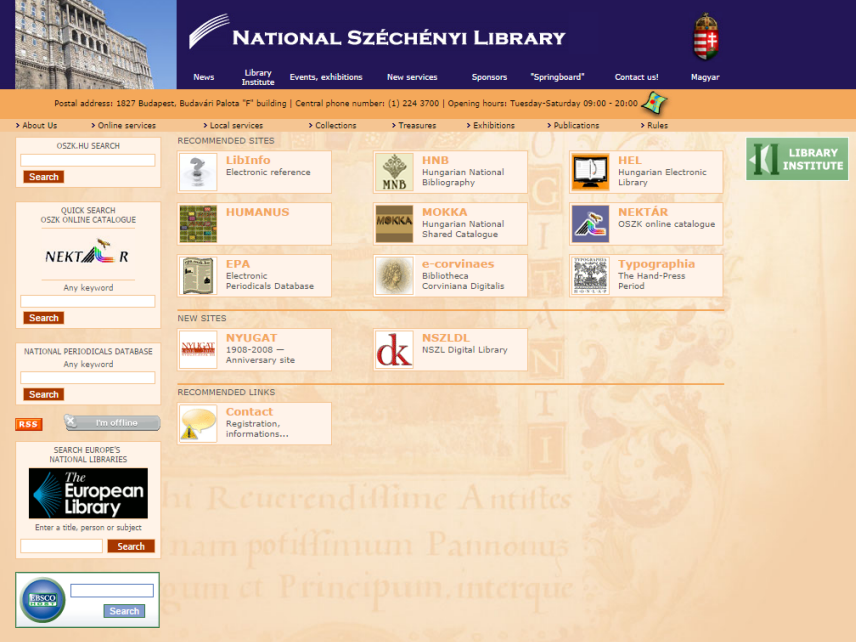
![]()
Latvijas Nacionala Biblioteka
The Latvian National library was established in 1919.The library has holdings of over 4 million volumes, which consist of Latvian and foreign editions on Latvia and Latvians, and works by Latvian authors. The online catalog provides access to the library’s acquisitions from 1996 on. The following databases are available from the website of the National Library:
- Electronic Union Catalog of 10 Latvian libraries of national significance
- Scanned Card Catalogs
- Authoritative Database of the NLL
- Analytics Database (articles from newspapers, magazines, collections)
- National Bibliography Database of Monographs and Serial Publications
- Applied Sciences database
- Letonica Description Items in Books
- Index to Printed Music in Collections
- Personalities of the Book Publishing Sector before 1918: Biographies
The catalog is very easy to search, and it may look familiar, as many of the other countries in the region use a similar interface. It does not require the use of diacritics to locate materials. When accessing the library catalog from the main National Library webpage, there is an interim screen that allows several options. The user can search all catalogs of the National Library of Latvia, or choose a part, such as Books, E-books, Serials, Theses and Abstracts, Maps, Electronic Documents, etc. There are also thematic databases: Applied Sciences database, Letonica Description Items in Books, and the Index to Printed Music in Collections.
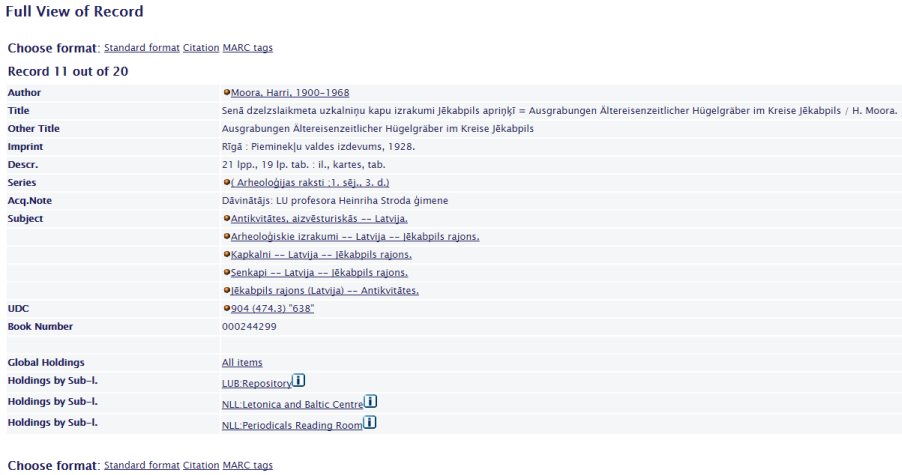
The interface for the basic search allows the user to search in either cyrillic or latin charcaters. This is a somewhat unusual feature and does make the catalog easier to manage. As can also be seen in this record, locational information is supplied. Searching in the Union Catalog will supply holdings at other Latvian institutions. There are several different types of searches offered, basic, advanced, multi-field and multi-base, as well as a Common Command Language Search. The selection of cyrillic or latin fonts is only available in the basic search. The other levels of search allow the user to perform more complex searches using combinations of different search fields but do not recognize cyrillic fonts.
![]()
Lietuvos Nacionaline Martyno Mazvydo Biblioteka
Development of the national bibliographic database (NBDB) began in 1998. Since then the database has amassed over 1,844,154 bibliographic records (as reported 2011, 1 January). This was accomplished partly as a result of a depository law that required a copy of every book, pamphlet, sheet music, artistic production or reproduction, map, serial publication, audio or video recording, electronic resource and Braille publication be deposited in the National Library.
The library was also responsible for collecting and recording in the national bibliographic database all obtainable publications about Lithuania (Lituanika) and incorporating retrospective records for publications issued from 1547-1917 and small print run titles issued between 1918 and 1940.
Records of Yiddish publications collected in the library since the beginning of the 19th century are also available in a separate database accessible via the menu on the main catalog page.
This library has an extensive collection of Russian and Polish language materials that should not be overlooked.
National Bibliographic Databank: The Data Bank houses many databases as described in our National Bibliography of Lithuania guide under the online resources section. Within the NBDB, there are two databases that deal specifically with periodicals and articles.

The NBDB offers bibliographic information for articles from the year 2003 to the present. The search interface is provided by LIBIS and is available in English by clicking the little British flag in the top right-hand corner of the screen. But the default “Simple” search does not include articles- for that the patron must click the tab that says “Articles Search” or ” Straipsnių paieška” if the patron is using the site in Lithuanian. The search is the same in every aspect except in choice of languages. The Lithuanian version of the search has a much longer list of languages than the English site. Keep that in mind when having trouble searching in the English interface.
Much like the Bibliographic articles database, the journal or “in publications” field must be filled using the button next to the box; you cannot type anything in the box even if you tried. The articles search on the NBDB offers many fields to fill in or leave blank. The “author.group” and “about person” fields also have the option of being automatically filled by the database’s dictionary. This is a helpful feature if one is not sure of the spelling of an author’s name. Furthermore, by using the “about person” field the patron can find articles that discuss a person’s work, not only their own writing. There is also a lag time between search and results – patience is a must.
![]()

Biblioteka Narodowa – The National Library of Poland
Polish and English versions of this catalog’s interface are available. To access the library catalog select: Katalogi BN in the top right-hand corner of the homepage. The site also provides access to a wide menu of databases. Select:”Katalogi i bibliografie” from the top menu, which leads to a landing page for the different BN databases. Some of the databases include:
- Ksiazki polskie podziemne (1976-1989)–Polish Underground Books
- Polonica zagraniczne
- Bibliografia Zawartosci Czasopism
- Centralny Katalog Ksiazek Zagranicznych (1975-1986)
- Artykuly z gazet i tygodnikow polskich (2005-)
The catalog of Polish national library collection allows for a variety of search strategies. While one cannot search in cyrillic scripts, cyrillic language materials are included in the catalog in transliterated format. A search of the holdings of the National Library catalog will return a record like the one seen to the right.
![]()
Biblioteca Nationala a Romaniei
The National Library has more than 8,000,000 volumes. The online library catalog contains all the paper materials in the collection of the Romanian National Library from 1993 to the present. This includes Romanian and foreign publications, book and periodicals, multimedia documents and articles in periodicals culture. The catalog allows for a variety of searches and the interface is the same ALEPH product that many of the national libraries use. Search types include: a simple keyword search, a complex boolean search allowing the user to search a number of terms in different fields and a browse of authors and subjects. There are records for some publications that date back to the early part of the century, there are also numerous current publications. There are many other catalogs and databases available to search through the main catalog interface.
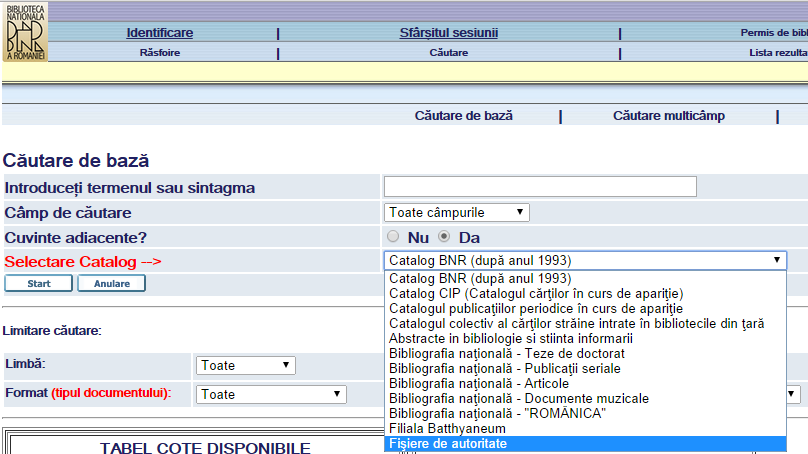
![]()
Rossiiskaia Gosudarstvennaia Biblioteka
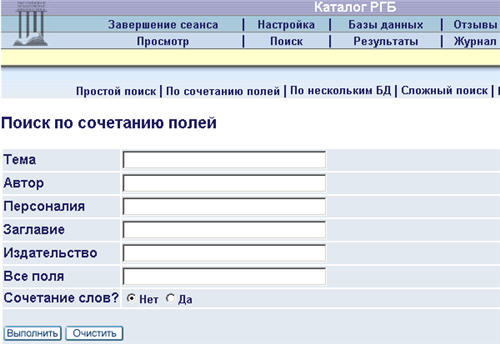
This is the web site of the Russian State Library, formerly the Leninka. Again, the interface of the library catalog will seem familiar, as the reader will note in the image on the left. The site is in Russian and requires the use of Russian fonts. The library has numerous resources. The list of online resources is included in the pages on Russia’s national bibliography. Some of the source included are the library’s monographic acquisitions from 1994 through most of 2002. The first search a researcher encounters performs a general search in the library’s catalogs. Information on each item is very thorough as can be seen from the sample entry below. This particular item was the result of a general search on three terms all of which are highlighted wherever they appear in the record.
The Russian State Library’s website, web resources and online catalogs have increased rapidly over the last several years. The main library website, linked in the title above, offers a simple search box with a few options below it. Using this search interface will yield a list of results based on the individual database or catalog. From that page, the user will link out to the actual results of his or her search. Elektronnyi katalog refers to the main library catalog of the Russian State library, pictured to the left. The main search box can also collect results from Elektronnaia biblioteka (the digital library) and Vneshnie resursy (external resources).
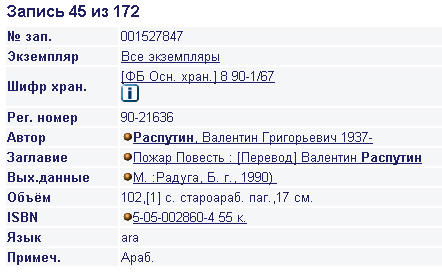
There are a large variety of options for both the results and the search. It is also possible to search several databases in this catalog. As the library expands its holdings it will become an ever more essential resource. Together with a search of the Russian National Library and its retrospective scanned catalog the researcher has access electronically to a great deal of information on Russian library holdings.
There are other catalogs: books received in the library in the last week; journals received since 1998, dissertations received since 1995 and maps and atlases obtained since 1985. The catalogs are easy to search.
It is important to note that the Russian State Library has an easy to use interface for Inter Library Loan requests. Institutions may register as users, then library patrons can request materials through ILL. Typical ILL payments are accepted, as well as Credit Cards.
![]()
National Library of Serbia
For a thorough description of this catalog and all of its features see our section on Serbian National Bibliography. This site contains much information about the Library and the library profession in Yugoslavia including many full-text articles and laws pertaining to libraries. This catalog uses the same interface as that found in the Slovene, Bosnian, Macedonian and Montenegrin consortia–162 Serbian libraries have contributed data to this library catalog, including 55,000 links to e-resources, 1.6 million books, 780,000 articles, 70,000 journals, 190,000 non-book material etc. .The search interface allows for complex searches in both cyrillic and latin characters.

The National Library of Serbia’s website includes more resources than just a link to the COBISS catalog. There are a number of very valuable resources that can be found at this site including a the Printed Book Catalogue 1868-1972, which contains materials in all Yugoslav national languages. The catalog includes about 300,000 monographic publication titles, and books printed from 1868 to December 31, 1972.
There are address lists and links to other Yugoslav libraries. Yugoslav CIP data can also be found at this site as well as contact information for library staff.
![]()
Slovenska narodna kniznica
This is the site of the Slovak National Library and a more detailed description of the features of its catalog can be found on the Czech and Slovak National bibliography page. This website provides access to the Slovak National library’s on-line catalogs of monographs and of articles as well as the Slovak Union Catalog. The catalogs have an optional English interface, but they do require Slovak fonts. The site includes links to other on-line library catalogs of the Slovak and Czech Republics.
Narodna in Univerzitetna Knjiznica
The web site of the National Library of Slovenia contains general information about the library, its collections, and publications. The section on Slovene National Bibliography has an excellent discussion of the Slovene catalogs available at this site.
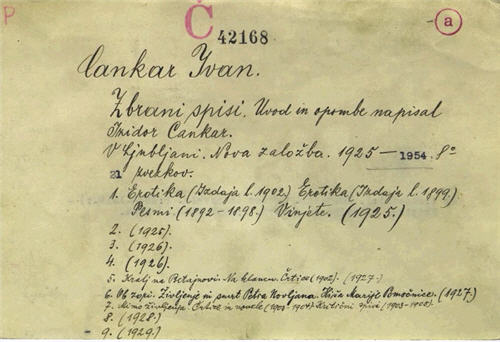
As noted in that discussion, there are several catalogs of both current and retrospective materials available at this site. The image above is an example of an entry from the catalog of materials published between 1774 and 1947. The catalog requires that the user download a plug-in in order to search but for those working on materials published in this region or planning a research trip it is well worth the trouble.
![]()
National Library of Ukraine
The library site is rich in resources. The library catalog, which includes some 204, 000 Ukrainian publications from 1994 on, is available as is a separate catalog of the library’s holdings of foreign language materials from 1980-1996. There is also an index of periodical publications.
As one would expect, the Ukrainian publications must be searched using Ukrainian Cyrillic, Russian publications must be searched in Russian, Western publications with Latin fonts. A search will return a list of titles with full bibliographic information. The searches are a bit difficult to navigate but the back button on the browser serves in place of a navigation button taking the searcher back to the initial search screen. It is possible to return to the library’s home page from each search result screen. The advanced search will allow the researcher to search by numerous fields including author, title word, subject, rubric, date of publication. It is possible to see a list of the rubrics from the search screen.
Numerous links will assist any scholar interested in the Ukraine in finding other sites with electronic journals, newspapers, search engines and other resources.
![]()
Directories of Online Catalogs
Bibliotheks-OPACs und Informationsseiten, Weltweit
(website down currently, try other German catalogs such as Karlsruhe)
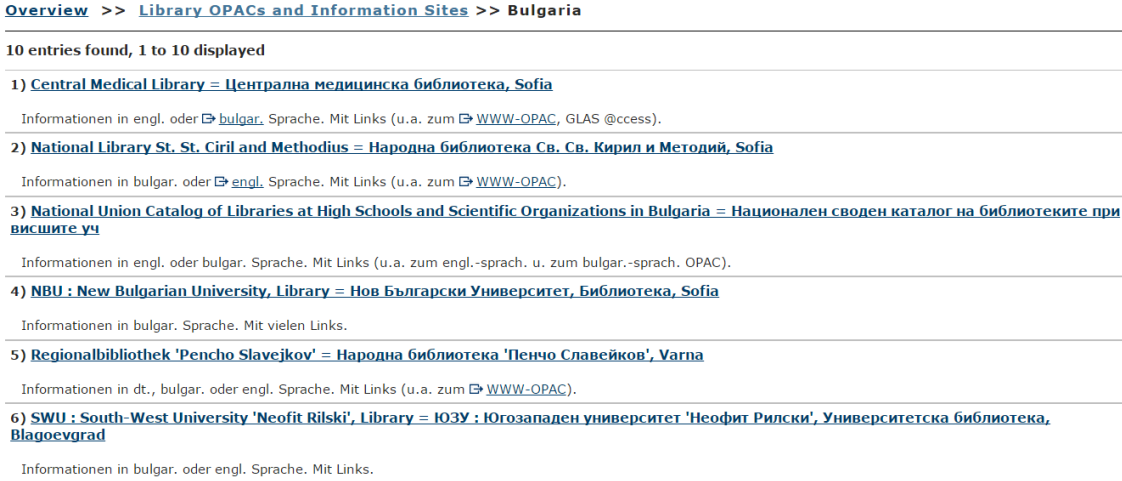
This German website has a number of tools that are useful for librarians. Among them is the list of links to library OPACs organized by country. The links to each country provide a page with a variety of services. The example above shows some of the links provided on the libraries and online catalogs of Bulgaria. This is a useful source for a more complete listing of the libraries of the Slavic world than can be found using lib-web-cats or lib-dex. The directory does not provide much information on the links and what information is provided is in German.
![]()
CIPAC-Scanned card catalogs
This list of scanned or digitized card catalogs is a quick way to find catalogs with extensive retrospective contents. The list is organized by country but no information is provided about the catalogs. Even with the lack of information about the library catalogs this is a very useful tool for those looking for a quick list of libraries with retrospective tools.
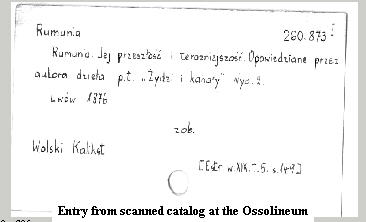
![]()
The European Library – Homepage
This site is more than just a list of links to Europe’s National Library catalogs. There is a wealth of information about each collection and its services at this site. The site provides a list of links to the online services of each library, the information pages of the national libraries, exhibitions and many other options. There is also a search utility that will allow you to search by keyword. The profiles on the individual libraries are very extensive and often have very useful historical information on the development of the collections. Unfortunately, some of the information on online services is somewhat out of date and it is useful to check other sources if you are not finding the information you need.
GABRIEL (Gateway and Bridge to Europe’s National Libraries) began in 1997, when the project set out to create a joint web portal of Europe’s national libraries. It was followed by TEL (The European Library) project, which ran from 2001-2004. The first web portal launched in 2005.
![]()
Lib-dex
Let’s say you are in a situation where you have found a list of libraries that might hold that one issue of a journal you need. Before sending a request through your Inter Library Loan department it is worth your time to check the individual library catalog to be sure that the institution listed actually holds the issue you need. Lib-dex is one of several web sites that can be very useful for this purpose. The site is organized by geographic location, and type of library. It has links to a number of useful utilities for librarians.
There are links to thousands of libraries world wide from this site. It can, therefore, be useful in searching for holdings at European institutions as well as those in North America. However, there are limitations to these directories. There are very few Cyrillic language libraries listed here. So, as with the next resource this is best used when seeking an online catalog in the United States.
![]()
Lib-web-cats
This is one of the favorite tools of the Slavic Reference Service. If you are seeking the online library catalog of an institution domestically or internationally this is one of the easiest resources to use. The researcher can simply enter the name of the institution and get a link either to the catalog or to the library’s home page.
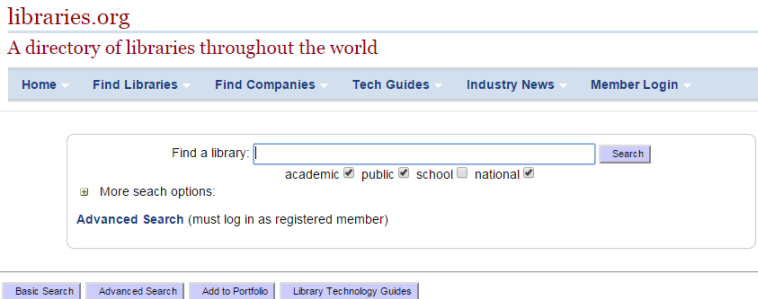
It is possible to search by country in this catalog of catalogs. Such a search will quickly reveal one of the shortcomings of this database. It is not comprehensive for foreign catalogs. It is a very good tool when searching for holdings in the U.S. or Western Europe and as such can be very useful when planning domestic research.
![]()
